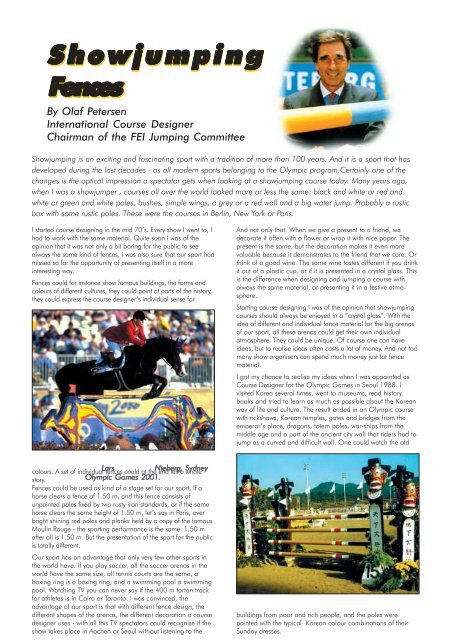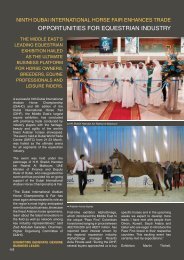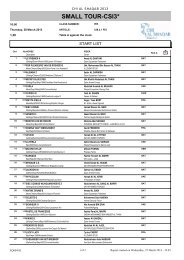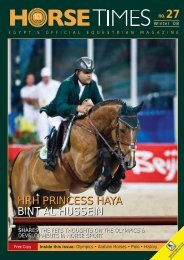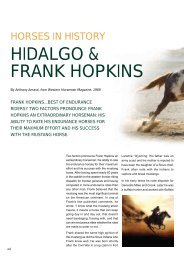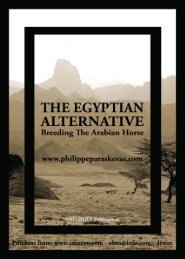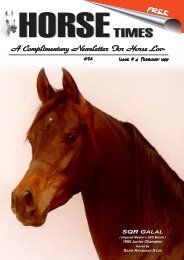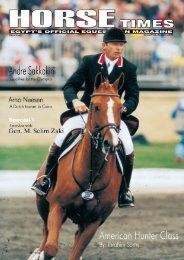HORSES OF THE DUTCH HORSES OF THE DUTCH - Horse Times
HORSES OF THE DUTCH HORSES OF THE DUTCH - Horse Times
HORSES OF THE DUTCH HORSES OF THE DUTCH - Horse Times
You also want an ePaper? Increase the reach of your titles
YUMPU automatically turns print PDFs into web optimized ePapers that Google loves.
Showjumping<br />
Showjumping<br />
Showjumping<br />
Showjumping<br />
Fences Fences Fences Fences Fences<br />
Fences Fences Fences Fences<br />
By Olaf Petersen<br />
International Course Designer<br />
Chairman of the FEI Jumping Committee<br />
Showjumping is an exciting and fascinating sport with a tradition of more than 100 years. And it is a sport that has<br />
developed during the last decades - as all modern sports belonging to the Olympic program.Certainly one of the<br />
changes is the optical impression a spectator gets when looking at a showjumping course today. Many years ago,<br />
when I was a showjumper , courses all over the world looked more or less the same: black and white or red and<br />
white or green and white poles, bushes, simple wings, a grey or a red wall and a big water jump. Probably a rustic<br />
box with some rustic poles. These were the courses in Berlin, New York or Paris.<br />
I started course designing in the mid 70’s. Every show I went to, I<br />
had to work with the same material. Quite soon I was of the<br />
opinion that it was not only a bit boring for the public to see<br />
always the same kind of fences, I was also sure that our sport had<br />
missed so far the opportunity of presenting itself in a more<br />
interesting way.<br />
Fences could for instance show famous buildings, the forms and<br />
colours of different cultures, they could point at parts of the history,<br />
they could express the course designer’s individual sense for<br />
colours. A set of individual<br />
Lars ars fences could at the<br />
Nieberg Nieberg, Nieberg<br />
end tell a<br />
, Sydney<br />
whole<br />
Sydney<br />
Sydney<br />
story.<br />
Olympic Olympic Olympic Games Games 2001.<br />
2001.<br />
Fences could be used as kind of a stage set for our sport. If a<br />
horse clears a fence of 1.50 m, and this fence consists of<br />
unpainted poles fixed by two rusty iron standards, or if the same<br />
horse clears the same height of 1.50 m, let’s say in Paris, over<br />
bright shining red poles and planks held by a copy of the famous<br />
Moulin Rouge - the sporting performance is the same. 1.50 m<br />
after all is 1.50 m. But the presentation of the sport for the public<br />
is totally different.<br />
Our sport has an advantage that only very few other sports in<br />
the world have. If you play soccer, all the soccer arenas in the<br />
world have the same size, all tennis courts are the same, a<br />
boxing ring is a boxing ring, and a swimming pool a swimming<br />
pool. Watching TV you can never say if the 400 m tartan track<br />
for athletes is in Cairo or Toronto. I was convinced, the<br />
advantage of our sport is that with different fence design, the<br />
different shapes of the arenas, the different decoration a course<br />
designer uses - with all this TV spectators could recognise if the<br />
show takes place in Aachen or Seoul without listening to the<br />
And not only that. When we give a present to a friend, we<br />
decorate it often with a flower or wrap it with nice paper. The<br />
present is the same, but the decoration makes it even more<br />
valuable because it demonstrates to the friend that we care. Or<br />
think of a good wine. The same wine tastes different if you drink<br />
it out of a plastic cup, or if it is presented in a crystal glass. This<br />
is the difference when designing and jumping a course with<br />
always the same material, or presenting it in a festive atmosphere.<br />
Starting course designing I was of the opinion that showjumping<br />
courses should always be enjoyed in a “crystal glass”. With the<br />
idea of different and individual fence material for the big arenas<br />
of our sport, all these arenas could get their own individual<br />
atmosphere. They could be unique. Of course one can have<br />
ideas, but to realise ideas often costs a lot of money. And not too<br />
many show organisers can spend much money just for fence<br />
material.<br />
I got my chance to realise my ideas when I was appointed as<br />
Course Designer for the Olympic Games in Seoul 1988. I<br />
visited Korea several times, went to museums, read history<br />
books and tried to learn as much as possible about the Korean<br />
way of life and culture. The result ended in an Olympic course<br />
with rickshaws, Korean temples, gates and bridges from the<br />
emperor’s place, dragons, totem poles, war-ships from the<br />
middle age and a part of the ancient city wall that riders had to<br />
jump as a curved and difficult wall. One could watch the old<br />
buildings from poor and rich people, and the poles were<br />
painted with the typical Korean colour combinations of their<br />
Sunday dresses.


